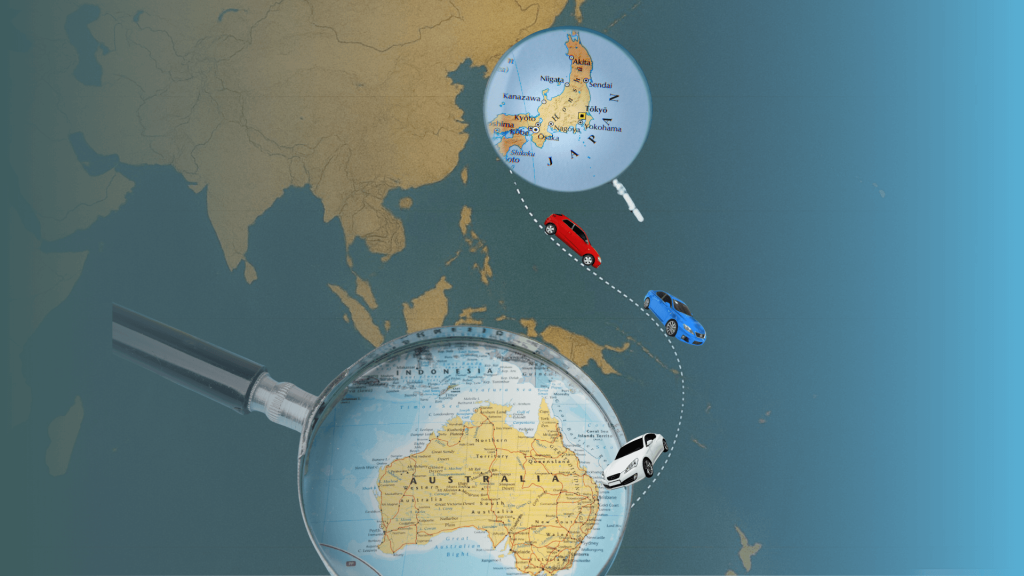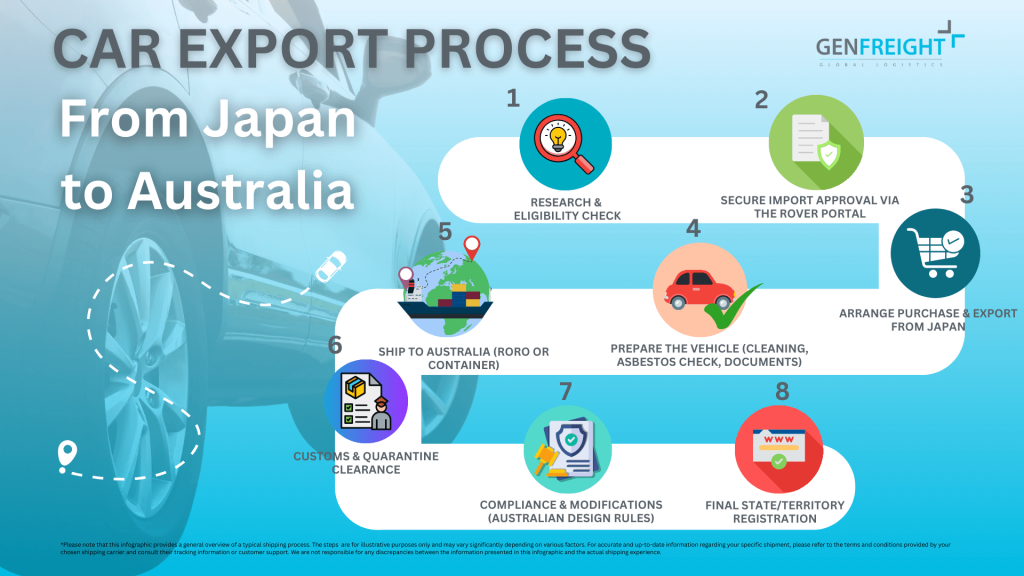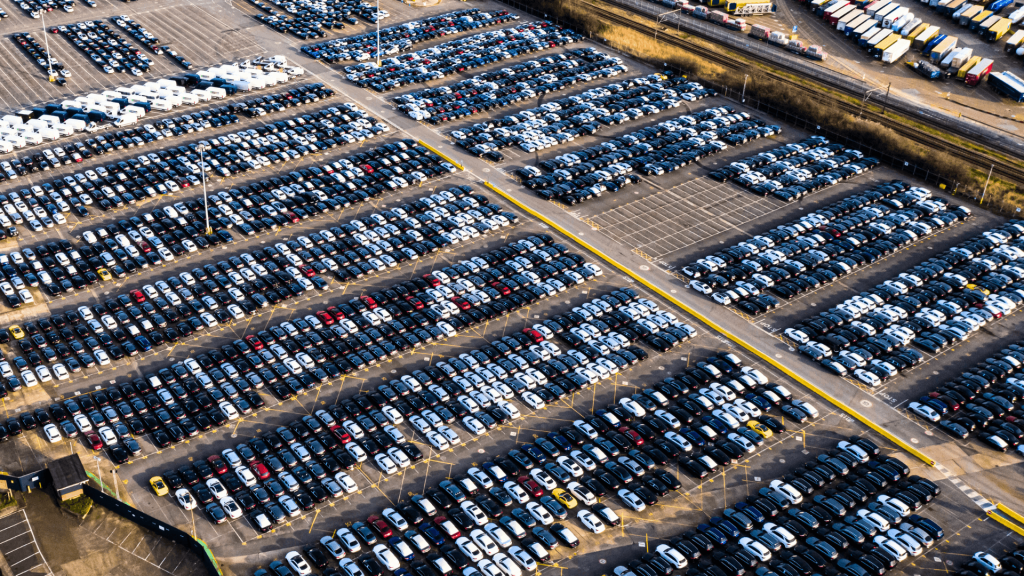If you’re a business owner or a keen enthusiast, the idea of importing a vehicle can seem complex, but the rewards are significant. Indeed, Japan is a treasure trove for discerning buyers, and for a very good reason. As we move through 2025, Japan continues to be the largest single source of vehicle imports into Australia, a position it has held for many years. Additionally, recent trends show a growing interest in Japanese-made EVs and highly efficient hybrid models. As a result, the market is becoming more diverse and exciting than ever before.

Why Japanese Cars?
First of all, Japanese vehicles are renowned for their exceptional maintenance culture, thanks to the country’s strict shaken (vehicle inspection) system. This mandatory check is both thorough and costly, which means many Japanese owners sell their cars while they are still in excellent condition. As a result, importers can access cars with low mileage, full service records, and minimal wear. Furthermore, Japan’s domestic market offers unique models and trims—often with advanced technology or performance features. Consequently, many of these vehicles were never officially sold in Australia. Finally, these vehicles typically hold strong resale value once registered, giving businesses and investors an attractive margin.
What This Guide Delivers
Of course, the process requires careful planning. This guide is your complete, one-stop-shop to demystify the entire import journey. Firstly, we will provide you with a comprehensive 8-step roadmap based on official Australian government regulations. This guide will then walk you through the entire process. Moreover, we’ll give you a detailed breakdown of all the costs, including taxes and hidden fees, so you can budget accurately. Finally, you’ll get invaluable insider tips to help you avoid common mistakes and streamline the process from start to finish.
Think of it as a checklist you can follow. To give you a clear, high-level overview of the process, here is a simplified visual roadmap of your import journey:
- Research & Eligibility Check
- Secure Import Approval via the ROVER Portal
- Arrange Purchase & Export from Japan
- Prepare the Vehicle (cleaning, asbestos check, documents)
- Ship to Australia (RORO or container)
- Customs & Quarantine Clearance
- Compliance & Modifications (Australian Design Rules)
- Final State/Territory Registration
Key Rules & Pathways You Must Know
Before you even think about putting a deposit down, you must understand the rules that govern vehicle imports. Ultimately, navigating the Australian legal landscape is the single most important step in your entire import journey.
The 25-Year Rule: Importing a Classic
The 25-Year Rule is a primary pathway for classic and historic vehicle importers. This is a rolling rule, meaning any vehicle manufactured 25 years or more prior to the date you apply for approval is eligible. Importantly, this rule provides an exemption from some modern Australian Design Rules (ADRs). Nevertheless, the vehicle must still meet all the ADRs that were in effect during its original year of manufacture. For business owners, this is an incredible opportunity to import a wide range of rare or classic models that were never sold in the Australian market.
Specialist & Enthusiast Vehicle Scheme (SEVS)
Additionally, for vehicles that are newer than 25 years but have unique features or were never sold in Australia, the Specialist and Enthusiast Vehicle Scheme (SEVS) provides a viable import pathway. SEVS ensures that these vehicles meet safety and emissions standards while allowing access to models with special performance, styling, or historical significance. For your convenience, you can check whether a vehicle is eligible by visiting the official SEVS/ROVER register here: ROVER Portal.
The Japanese “3-Year Rule” Explained
Interestingly, Japan’s domestic market also affects the supply of vehicles available for export. Under the 3-Year Rule, many Japanese owners choose to sell their cars after three years because of the high costs of the shaken (mandatory vehicle inspection). Consequently, this system produces a steady supply of well-maintained, low-mileage vehicles that are ideal for Australian importers seeking quality cars. Understanding this rule can help businesses time their purchases for the best deals.
List of Approved Vehicles
Finally, it is crucial to know which vehicles are eligible for import. Both SEVS and the 25-Year Rule maintain lists or databases of approved vehicles. Businesses can search the official ROVER/SEVS database to confirm eligibility and avoid purchasing a car that cannot legally enter Australia. Popular examples of vehicles often imported include classic Japanese sports cars, unique performance models, and certain hybrid or electric models that meet SEVS criteria.
List of most popular Japanese cars for export to Australia
Below list highlights some of the most reliable and popular Japanese cars to import to Australia in 2025. It includes family cars, hybrids, and electric vehicles that are well-known for their quality and value. However, before arranging any shipment, you still need to check whether the car is eligible for import under the official rules.
Family Cars and People Movers
- Toyota Estima
- Toyota Axio (Corolla sedan)
- Toyota Alphard
- Toyota Noah/Voxy
- Nissan Elgrand
- Honda Odyssey
- Nissan Cube
- Toyota Corolla Fielder
- Toyota HiAce
EVs and Hybrids
- Toyota Prius (various generations)
- Toyota Estima Hybrid
- Toyota Noah/Voxy Hybrid
- Toyota Alphard Hybrid
- Nissan Note e-POWER
- Honda Insight
- Nissan Leaf
- Mitsubishi Minicab MiEV, Nissan Sakura (kei EVs)
Sports and Enthusiast Models (for context)
- Nissan Skyline GT-R (R32/R33/R34)
- Toyota Supra (A80)
- Mazda RX-7 (FD)
- Nissan Silvia (S13, S14, S15)
- Mitsubishi Lancer Evolution (VI-IX)

The Official 8-Step Roadmap to Importing
Importing a car from Japan to Australia may seem complex, but by following this step-by-step roadmap, businesses can navigate the process smoothly. Each step below reflects government requirements while providing plain-English explanations and practical tips.
Step 1: Research & Eligibility Check
This initial step is absolutely non-negotiable. Firstly, you must confirm that the vehicle you intend to import is eligible under one of Australia’s import pathways, like the 25-Year Rule or the SEVS scheme. Furthermore, you’ll need to gather all necessary documentation, from proof of ownership to the vehicle’s specifications. Most importantly, use this time to create a full budget, as outlined later in this guide, to understand the total costs involved. Skipping this step is the most common reason for costly mistakes and delays.
Step 2: Apply for Import Approval via ROVER
Once you’re confident in your vehicle choice, you must apply for import approval through the official online system, ROVER (Road Vehicle Regulator). This application is a legal requirement and must be completed and approved before the vehicle is shipped from Japan. In fact, shipping a vehicle without an approval is a serious offense that will result in the car being seized and either re-exported or destroyed at your expense.
Step 3: Receive Approval & Conditions
Once your application is submitted, the Department of Infrastructure, Transport, Regional Development, Communications, and the Arts will assess it. If approved, you will receive a formal approval letter. This document is crucial and must be kept safe, as it is required for customs clearance upon the vehicle’s arrival. The approval may also include specific conditions that must be met, such as required modifications or inspections.
Step 4: Arrange Shipping
With your import approval in hand, you can now arrange shipping. You generally have two primary options:
- Roll-on/Roll-off (RORO): This is the most common and cost-effective method. The car is simply driven onto a large vessel and secured for the journey.
- Container Shipping: This offers greater protection for your vehicle as it is loaded into a dedicated container, either by itself or with other cargo. While more expensive, it is often preferred for high-value or classic cars.
Prior to shipment, you must complete some critical pre-checks. This includes ensuring that the vehicle is professionally cleaned to meet Australian biosecurity standards. Additionally, check for asbestos (especially in older cars) and remove any restricted air-conditioning gas. Moreover, consider insurance and timing to avoid peak shipping periods.
Step 5: Customs Clearance
When your vehicle arrives in Australia, it enters a bonded warehouse under the control of the Australian Border Force (ABF). At this point, you (or more commonly, your customs broker) must lodge an Import Declaration and pay all applicable duties, GST, and any Luxury Car Tax. A customs broker is an invaluable asset here. They are experts in navigating the paperwork and regulations, helping you avoid mistakes that can lead to fines or extensive delays.
Step 6: Quarantine & Biosecurity
After customs clearance, your vehicle will be inspected by a biosecurity officer from the Department of Agriculture, Fisheries and Forestry (DAFF). Undoubtedly, Australia’s biosecurity laws are incredibly strict. So the vehicle will be thoroughly checked for any foreign matter, including soil, seeds, plant material, or insects.
If contamination is found, the vehicle will be ordered to be cleaned, fumigated, or, in severe cases, re-exported or destroyed. To avoid these costly delays, always ensure your car is professionally cleaned, especially the undercarriage and wheel wells. By doing so, you can help guarantee a smoother shipping process from Japan.
Step 7: Meet Compliance Requirements
For SEVS vehicles or others requiring compliance, the car is then transported to a Registered Automotive Workshop (RAW). The RAW’s job is to inspect and modify the vehicle to meet the relevant Australian Design Rules (ADRs). This can involve a range of work, from headlight adjustments and seatbelt replacements to emissions testing. Once the work is complete, the RAW will issue a compliance plate, and your vehicle will be listed on the Register of Approved Vehicles (RAV), signifying it is roadworthy.
Step 8: State/Territory Registration
Finally, the car must be registered in the state or territory where it will be driven. This process is handled by the relevant transport authority (e.g., VicRoads, Transport WA, Service NSW). Moreover, each state has slightly different requirements and fees, so it’s important to check local regulations. Generally you will need to present your import approval, RAV entry record, and a current roadworthy certificate. Then you can pay the final fees and get your new number plates.
Comprehensive Cost Breakdown: What to Budget for (2025 Estimates)
Understanding the full financial picture is arguably the most important part of any successful import. There is more to the total cost than just the vehicle’s purchase price. It’s a combination of fees from both sides of the globe.
Japan-Side Costs
These are the fees you will pay before the car leaves Japan. Naturally, these costs are dependent on your chosen export agent and the vehicle’s location.
- Vehicle Purchase Price. Firstly, Vehicle Price is the cost of the car itself, whether from a dealer or a Japanese car auction.
- Exporter/Agent Fees. Secondly, expect to pay a service fee to your export agent for sourcing the car, managing paperwork, and arranging transport to the port. Generally these can vary, but most reputable companies will charge a transparent, fixed rate.
- Inland Transport. Thirdly, this is the cost of getting the car from its original location (e.g., an auction house in Osaka) to the nearest port for shipment. Moreover, it can range significantly depending on the distance.
- Export Customs Clearance.Finally, Export Customs is a fixed fee for officially clearing the car for export from Japan.
Australia-Side Costs
These costs are paid once the vehicle arrives in Australia and are the most complex to calculate.
• Shipping.
Typically the most common option is RORO (Roll-on/Roll-off). As a guide for 2025, RORO shipping for a standard vehicle (under 12 cubic meters) to a major port like Brisbane, Melbourne, or Sydney typically costs between $1,500 and $3000 AUD. Moreover, larger vehicles or container shipping will be significantly more expensive.
• Customs Duty & GST.
Thanks to the Japan-Australia Economic Partnership Agreement (JAEPA), there is now a 0% customs duty on most vehicles imported from Japan. However, the Goods and Services Tax (GST) still applies at 10% of the vehicle’s landed value (which includes the purchase price, shipping, and insurance).

• Luxury Car Tax (LCT).
This is a federal tax that applies to vehicles sold or imported above a certain value. Typically the tax rate is 33% on the portion of the value that exceeds the threshold. For example for the 2025-26 financial year, the thresholds are:
- $91,387 for fuel-efficient vehicles (those consuming 3.5L/100km or less).
- $80,567 for all other vehicles.
Worked Example: Calculating Your LCT Let’s assume you import a non-fuel-efficient car with a landed value of $95,000.
- Taxable Amount: $95,000 – $80,567 (LCT threshold) = $14,433
- LCT Payable: $14,433 x 33% = $4,763
• Quarantine & Cleaning.
Biosecurity is serious business. While a professional pre-shipment clean helps, a biosecurity officer may order an additional inspection or treatment at the port. Also these fees can range from a few hundred dollars to over a thousand if a major cleaning is required.
• Compliance/RAW Fees.
Moreover, costs for ensuring the vehicle meets Australian Design Rules (ADRs), which can include inspections and necessary modifications. Generally these costs can vary widely depending on the vehicle and required changes.
• Broker & Port Fees.
In summary, a realistic estimate for broker and port fees combined is approximately AUD 700 to 2,000. Of course, this amount can vary depending on the specific services required and the port used.
Pro Tip: Budget for Contingency
When setting your budget, always set aside an extra 10-15% for contingencies. This buffer is crucial for covering unforeseen costs like additional cleaning, unexpected compliance issues, or currency fluctuations.
Conclusion
In short, importing a car from Japan to Australia is straightforward if you follow the 8-step roadmap, budget carefully, and work with trusted partners. Always check your vehicle’s eligibility on the ROVER portal before making any arrangements.
For professional support with shipping, compliance, and registration, you can contact GenFreight, a global freight forwarder that helps businesses import vehicles smoothly and efficiently.
FAQs:
1: How do I get import approval for a car in Australia?
Import approval must be obtained before shipping via the official ROVER portal. The application includes submitting vehicle details, documents, and sometimes paying fees. Approval may come with conditions to meet once the car arrives.
2: What is the ROVER system?
ROVER is the Australian government’s online portal for managing vehicle import approvals. It helps businesses check eligibility, submit applications, and track the approval process.
3: Can I import a car with asbestos?
No. Vehicles containing asbestos are not allowed in Australia. All imports must pass a certified asbestos inspection before shipping or entry.
4: How long does the whole process take from purchase to registration?
Typically, the process takes 8–16 weeks, depending on shipping, customs, quarantine inspections, and compliance modifications. Planning ahead and working with experienced partners can help speed up the timeline.
